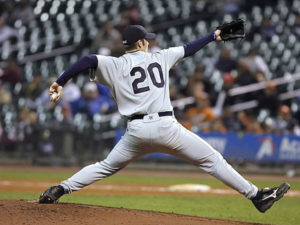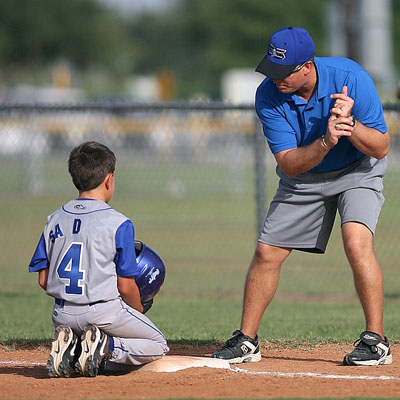
One of the most interesting yet challenging aspects of taking care of baseball players are discussions regarding injuries to the ulnar collateral ligament. This condition, which is extremely common, causes medial or inner elbow pain in overhead athletes. It can be seen in baseball or softball players, volleyball players, football players, or track and field athletes. It is certainly extremely common in the sport of baseball.
This condition is diagnosed with a proper history and physical exam, as well as input from x-rays and an MRI.
As is often the case, there are a spectrum of injuries and a lot of terminology that is thrown around. Sometimes this can be confusing for the patient and their families. It is my job to help to sort it out. Words like sprain, tear, complete versus incomplete, partial, etc. can often be used. This can create confusion and anxiety, but a good sports medicine physician can help you sort things out.
For baseball players with a complete detachment of the ligament from their elbow, Tommy John surgery is unequivocally recommended. This has an excellent track record and a very favorable return to pre-injury activity levels. For patients with pain, loss of velocity, or inability to compete at the proper level with a complete or full thickness tear of the ligament, this treatment approach works well and typically should be followed.
Decisions exist and uncertainty arises when there are partial or incomplete tears of the ligaments. Some people will be candidates for nonsurgical options – most commonly, this refers to treatment with an injection of the patient’s own blood, called platelet rich plasma, or PRP. PRP uses a centrifuge machine to spin down a sample of blood from the patient, to inject a specific layer of the blood that is rich in growth factors, platelets and cytokines-elements which helps stimulate a healing response. In some instances, we believe that the PRP can help the athlete’s native tissue to heal on its own without surgery. This is not always the case, however.
Not everybody is a candidate for PRP. There are certain things which come into play that need to be discussed with your physician. Briefly, this includes the time of the year during which the athlete is being seen, the prior history of injuries or lack thereof about the elbow, and the specific characteristics of the ligament that we can see on the MRI, among other things. Some candidates have true potential to heal the ligaments with PRP and time. Others, unfortunately, will be unable to heal a ligament that is highly disorganized, stretched out, or badly injured, even if it is not completely torn off the bone.
When working on this problem together with you or your family member, we can come up with the best approach that makes sense, taking all of these variables into consideration. Indeed, it is a complex subject, but I and my team can help you sort it out.
 As summer is upon us, I thought it might be helpful to review some advice and practical tips for our overhead throwing athletes.
As summer is upon us, I thought it might be helpful to review some advice and practical tips for our overhead throwing athletes.


 Shoulder pain is a very common complaint in baseball players, for both pitchers and position players all too regularly. Fortunately, the vast majority of these can be treated without surgery, and just require proper evaluation by a sports medicine physician who can then organize the treatment plan to get the athlete healthy again.
Shoulder pain is a very common complaint in baseball players, for both pitchers and position players all too regularly. Fortunately, the vast majority of these can be treated without surgery, and just require proper evaluation by a sports medicine physician who can then organize the treatment plan to get the athlete healthy again. One of the most important ways in which to keep our young athletes healthy, when they’re involved in baseball for most or all of the year, is by pitch counts. Perhaps it would be more appropriate to call them pitch limits. Fortunately, through research we have been able to establish some reasonable guidelines to help keep young throwing arms as healthy as possible. The best website I have found is
One of the most important ways in which to keep our young athletes healthy, when they’re involved in baseball for most or all of the year, is by pitch counts. Perhaps it would be more appropriate to call them pitch limits. Fortunately, through research we have been able to establish some reasonable guidelines to help keep young throwing arms as healthy as possible. The best website I have found is  By now a majority of people have heard of PRP, which stands for platelet-rich plasma. This is a procedure performed by a physician in the office that involves taking a small sample of blood from a patient. That blood is then placed into a centrifuge machine, which helps to separate the blood into different layers based upon their densities. A specific density layer is targeted which contains the platelets and growth factors responsible for the healing process invoked when we have injured tissues. This layer is then typically injected into patients at the target site of injury, often under ultrasound to enhance the precision of the injection.
By now a majority of people have heard of PRP, which stands for platelet-rich plasma. This is a procedure performed by a physician in the office that involves taking a small sample of blood from a patient. That blood is then placed into a centrifuge machine, which helps to separate the blood into different layers based upon their densities. A specific density layer is targeted which contains the platelets and growth factors responsible for the healing process invoked when we have injured tissues. This layer is then typically injected into patients at the target site of injury, often under ultrasound to enhance the precision of the injection. My child has a growth plate fracture in their arm – should I be really worried?
I see patients of all ages, from toddlers to the elderly. A large part of my practice involves treatment of routine injuries in children, adolescents, and teenagers. Fractures of the hand, wrist, forearm and elbow are very common.
Here’s a little bit about how we grow: The growth plates are the centers of growth and the location of lots of injuries. We get longer in our bones because of the growth plates. The growth plate is also the weak spot on the bone. It is largely made up of cartilage which eventually ossifies or turns into bone – like the remainder of the more mature bone. The cartilage isn’t as strong as regular bone.
My child has a growth plate fracture in their arm – should I be really worried?
I see patients of all ages, from toddlers to the elderly. A large part of my practice involves treatment of routine injuries in children, adolescents, and teenagers. Fractures of the hand, wrist, forearm and elbow are very common.
Here’s a little bit about how we grow: The growth plates are the centers of growth and the location of lots of injuries. We get longer in our bones because of the growth plates. The growth plate is also the weak spot on the bone. It is largely made up of cartilage which eventually ossifies or turns into bone – like the remainder of the more mature bone. The cartilage isn’t as strong as regular bone. How can I rest my throwing arm when there is never any off-season?
How can I rest my throwing arm when there is never any off-season? Most of us have heard of the phrase – “The art of medicine”. That refers to the unique interaction between a physician and their patient, taking into account all of the particular and individual nuances that make up one patient’s problem(s). The same treatment will not work universally for every patient. A physician draws upon their experiences and their fund of knowledge to customize the care provided to each individual patient. That, in essence, is the art of medicine.
Most of us have heard of the phrase – “The art of medicine”. That refers to the unique interaction between a physician and their patient, taking into account all of the particular and individual nuances that make up one patient’s problem(s). The same treatment will not work universally for every patient. A physician draws upon their experiences and their fund of knowledge to customize the care provided to each individual patient. That, in essence, is the art of medicine. One of the most interesting yet challenging aspects of taking care of baseball players are discussions regarding injuries to the ulnar collateral ligament. This condition, which is extremely common, causes medial or inner elbow pain in overhead athletes. It can be seen in baseball or softball players, volleyball players, football players, or track and field athletes. It is certainly extremely common in the sport of baseball.
One of the most interesting yet challenging aspects of taking care of baseball players are discussions regarding injuries to the ulnar collateral ligament. This condition, which is extremely common, causes medial or inner elbow pain in overhead athletes. It can be seen in baseball or softball players, volleyball players, football players, or track and field athletes. It is certainly extremely common in the sport of baseball.